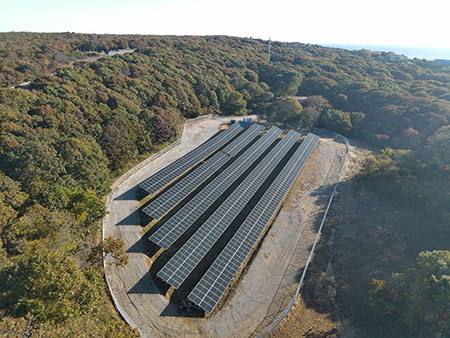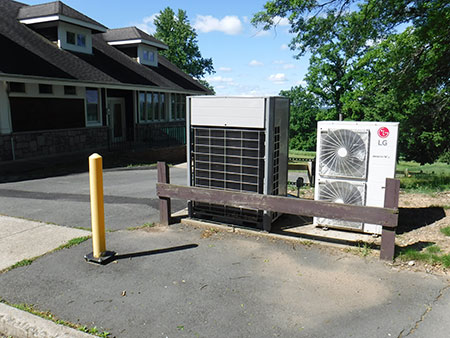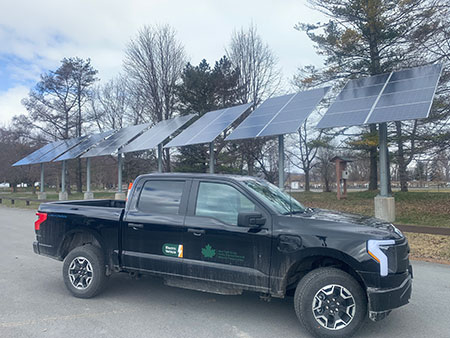NY State Parks Are Championing Clean Energy

State Parks Are Combatting Climate Change With Solar Power, Energy Efficiency, and Electrification
Between cooling neighborhoods and sequestering stormwater, green spaces and public land are critical to making New York communities more resilient to the impacts of climate change, including more frequent heat waves and extreme weather events.
Perhaps best known for their scenic landscapes and cultural heritage, New York’s system of 250+ state parks, historic sites, recreational trails, golf courses and boat launches are also leading efforts to cut greenhouse gas emissions from their buildings and fleet vehicles.
In 2024, New York State Parks, Recreation & Historic Preservation (OPRHP) is celebrating its centennial anniversary ![]() , which provides an opportunity to not only look back on the last 100 years, but to look forward and ignite conversation and action around preserving lands for the next generation. OPRHP’s climate change policy recognizes that “climate change has and will continue to impact the natural, historic, and cultural resources the agency stewards for the people of New York.” A goal of the centennial campaign includes facing the realities of climate change by making park facilities more resilient to climate change and sea level rise through the next century.
, which provides an opportunity to not only look back on the last 100 years, but to look forward and ignite conversation and action around preserving lands for the next generation. OPRHP’s climate change policy recognizes that “climate change has and will continue to impact the natural, historic, and cultural resources the agency stewards for the people of New York.” A goal of the centennial campaign includes facing the realities of climate change by making park facilities more resilient to climate change and sea level rise through the next century.
Amid the work to preserve New York’s natural wonders and historic sites, modernizing building systems and transitioning to clean energy sources are a priority to ensure they’re accessible for future generations. With a record 84 million visitors in 2023, these efforts stand to spread awareness – and inspire action – on addressing the climate crisis by adopting solar panels, electric vehicles, and energy-efficient heat pumps.
Harnessing Solar for Renewable Electricity


Hither Hills State Park solar array.
OPRHP has committed to transitioning to 100% renewable electricity by 2030. This goal is being driven by investment in solar arrays, strategically sited on building rooftops, parking lots, and previously disturbed land.
Currently, there are over 50 solar installations within New York’s state parks and historic sites, totaling more than six megawatts of renewable energy, and 14% of OPRHP’s current annual electricity use.
Recent projects, including a 262-kilowatt solar array at Hither Hills State Park, are advancing progress toward the 100% renewable by 2030 goal. The Hither Hills project ![]() will save $45,000 a year in energy costs and offset more than half of the Long Island park’s annual electricity consumption.
will save $45,000 a year in energy costs and offset more than half of the Long Island park’s annual electricity consumption.
OPRHP is actively planning additional solar installations, with a focus on larger arrays that can cover the usage of entire parks and historic sites. Their next two projects, a 586-kilowatt solar array at Green Lakes State Park ![]() and a 263-kilowatt solar array at Thacher State Park, do just that. Once complete, the solar panels will generate enough clean power to offset 100% of electricity used at both parks.
and a 263-kilowatt solar array at Thacher State Park, do just that. Once complete, the solar panels will generate enough clean power to offset 100% of electricity used at both parks.
Advancing Building Efficiency and Decarbonization


Heat pump system at Rockland Lake State Park clubhouse.
New York’s state parks and historic sites include 6,000 buildings across more than 250 locations. Since 2014, OPRHP has been actively assessing energy performance across its building portfolio, with 55 ASHRAE Level II energy audits completed to date and another 21 planned over the next two years.
These energy assessments, also known as energy audits, help identify energy efficiency upgrades, including building envelope improvements, efficient lighting, occupancy sensors, and low water use fixtures that reduce onsite energy use. Audits are also key to cost-effectively phasing out the use of fossil fuels in building systems.
In 2021, OPRHP completed an energy assessment of the clubhouse at Rockland Lake State Park Golf Course ![]() in the Hudson Valley, which recommended replacing the propane boiler with an air source heat pump. The dual heating and cooling system has greatly improved comfort for staff and patrons, especially in summer.
in the Hudson Valley, which recommended replacing the propane boiler with an air source heat pump. The dual heating and cooling system has greatly improved comfort for staff and patrons, especially in summer.
Since 2015, OPRHP’s building energy efficiency upgrades have saved 702 metric tons of greenhouse gas emissions annually, or the equivalent of taking 167 gas-powered vehicles off the road. Moving forward, OPRHP is prioritizing electrification of all new or modified building systems to continue decarbonizing its facilities and cutting greenhouse gas emissions.
Charging Electric Vehicles and Landscaping Equipment Forward


All-electric Ford F-150 Lightning and solar array at Allan H. Treman
State Marine Park.
Stewardship of New York’s 250+ state parks and historic sites requires fleet vehicles and ground maintenance equipment.
As of March 2024, OPRHP has integrated 84 electric vehicles (EVs), including a mix of plug-in hybrids and battery-electric models, into its statewide fleet. To support EV buildout, there are 36 fleet charging stations, plus 28 public charging stations, at sites across New York State. OPHRP has developed an EV charging infrastructure plan to ensure progress keeps pace with EV adoption and the goal of a 100% light-duty EV fleet by 2035.
On a similar note, OPRHP is currently replacing gas-powered handheld equipment, such as chainsaws and leaf blowers, when they have reached their end of life, with all-electric handheld equipment. Though smaller in scale, gas-powered equipment emits considerable noise and air pollution. Making the switch to all-electric landscaping equipment stands to improve staff health and safety while creating a more serene environment for visitors.
As larger landscaping equipment becomes more commercially available, OPRHP is planning for all new purchases, when practical, to be electric models when replacing equipment that has reached their end of life over the next five years.
Ready to electrify your own outdoor equipment? Our Electric Yard Equipment Buyer’s Guide outlines tips and key considerations for making the switch.
More on Clean Energy in New York
New York’s clean energy transition is well underway. Continue reading about statewide and local efforts to advance New York’s clean energy economy.
- How New York is Preparing for an EV Future: Electric vehicle charging access is expanding at workplaces, public facilities, and multifamily housing across New York.
- New York Leads U.S. on Community Solar: New York’s two gigawatts of community solar provides equitable access to renewable energy for a variety of customers.
- Towns Advancing Clean Energy and Efficiency: Municipalities across New York are leading by example in reducing emissions and adopting clean energy in their communities.
- Transforming Brownfields for a Greener Future: Learn about New York’s work to advance renewable energy development on former industrial sites and underused spaces.
Sign Up For News
Stay up to date on energy-saving programs and incentives, best practices, and more.
Stay Connected